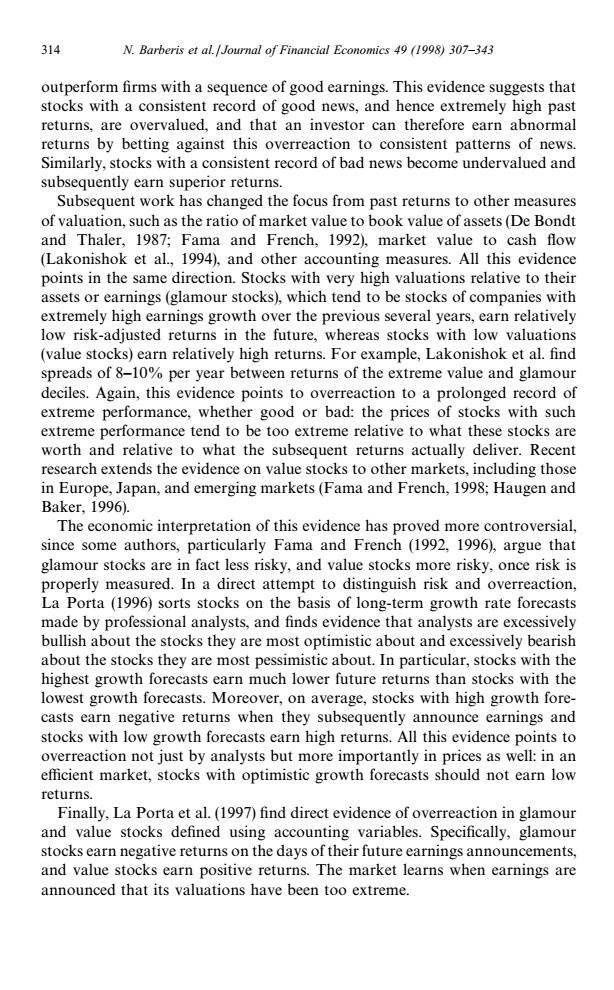正在加载图片...

314 N.Barberis et al./Journal of Financial Economics 49 (1998)307-343 outperform firms with a sequence of good earnings.This evidence suggests that stocks with a consistent record of good news,and hence extremely high past returns,are overvalued,and that an investor can therefore earn abnormal returns by betting against this overreaction to consistent patterns of news. Similarly,stocks with a consistent record of bad news become undervalued and subsequently earn superior returns. Subsequent work has changed the focus from past returns to other measures of valuation,such as the ratio of market value to book value of assets(De Bondt and Thaler,1987;Fama and French,1992),market value to cash flow (Lakonishok et al.,1994),and other accounting measures.All this evidence points in the same direction.Stocks with very high valuations relative to their assets or earnings(glamour stocks),which tend to be stocks of companies with extremely high earnings growth over the previous several years,earn relatively low risk-adjusted returns in the future,whereas stocks with low valuations (value stocks)earn relatively high returns.For example,Lakonishok et al.find spreads of 8-10%per year between returns of the extreme value and glamour deciles.Again,this evidence points to overreaction to a prolonged record of extreme performance,whether good or bad:the prices of stocks with such extreme performance tend to be too extreme relative to what these stocks are worth and relative to what the subsequent returns actually deliver.Recent research extends the evidence on value stocks to other markets,including those in Europe,Japan,and emerging markets(Fama and French,1998;Haugen and Baker,1996). The economic interpretation of this evidence has proved more controversial, since some authors,particularly Fama and French(1992,1996),argue that glamour stocks are in fact less risky,and value stocks more risky,once risk is properly measured.In a direct attempt to distinguish risk and overreaction, La Porta (1996)sorts stocks on the basis of long-term growth rate forecasts made by professional analysts,and finds evidence that analysts are excessively bullish about the stocks they are most optimistic about and excessively bearish about the stocks they are most pessimistic about.In particular,stocks with the highest growth forecasts earn much lower future returns than stocks with the lowest growth forecasts.Moreover,on average,stocks with high growth fore- casts earn negative returns when they subsequently announce earnings and stocks with low growth forecasts earn high returns.All this evidence points to overreaction not just by analysts but more importantly in prices as well:in an efficient market,stocks with optimistic growth forecasts should not earn low returns. Finally,La Porta et al.(1997)find direct evidence of overreaction in glamour and value stocks defined using accounting variables.Specifically,glamour stocks earn negative returns on the days of their future earnings announcements, and value stocks earn positive returns.The market learns when earnings are announced that its valuations have been too extreme.outperform firms with a sequence of good earnings. This evidence suggests that stocks with a consistent record of good news, and hence extremely high past returns, are overvalued, and that an investor can therefore earn abnormal returns by betting against this overreaction to consistent patterns of news. Similarly, stocks with a consistent record of bad news become undervalued and subsequently earn superior returns. Subsequent work has changed the focus from past returns to other measures of valuation, such as the ratio of market value to book value of assets (De Bondt and Thaler, 1987; Fama and French, 1992), market value to cash flow (Lakonishok et al., 1994), and other accounting measures. All this evidence points in the same direction. Stocks with very high valuations relative to their assets or earnings (glamour stocks), which tend to be stocks of companies with extremely high earnings growth over the previous several years, earn relatively low risk-adjusted returns in the future, whereas stocks with low valuations (value stocks) earn relatively high returns. For example, Lakonishok et al. find spreads of 8—10% per year between returns of the extreme value and glamour deciles. Again, this evidence points to overreaction to a prolonged record of extreme performance, whether good or bad: the prices of stocks with such extreme performance tend to be too extreme relative to what these stocks are worth and relative to what the subsequent returns actually deliver. Recent research extends the evidence on value stocks to other markets, including those in Europe, Japan, and emerging markets (Fama and French, 1998; Haugen and Baker, 1996). The economic interpretation of this evidence has proved more controversial, since some authors, particularly Fama and French (1992, 1996), argue that glamour stocks are in fact less risky, and value stocks more risky, once risk is properly measured. In a direct attempt to distinguish risk and overreaction, La Porta (1996) sorts stocks on the basis of long-term growth rate forecasts made by professional analysts, and finds evidence that analysts are excessively bullish about the stocks they are most optimistic about and excessively bearish about the stocks they are most pessimistic about. In particular, stocks with the highest growth forecasts earn much lower future returns than stocks with the lowest growth forecasts. Moreover, on average, stocks with high growth forecasts earn negative returns when they subsequently announce earnings and stocks with low growth forecasts earn high returns. All this evidence points to overreaction not just by analysts but more importantly in prices as well: in an efficient market, stocks with optimistic growth forecasts should not earn low returns. Finally, La Porta et al. (1997) find direct evidence of overreaction in glamour and value stocks defined using accounting variables. Specifically, glamour stocks earn negative returns on the days of their future earnings announcements, and value stocks earn positive returns. The market learns when earnings are announced that its valuations have been too extreme. 314 N. Barberis et al./Journal of Financial Economics 49 (1998) 307—343